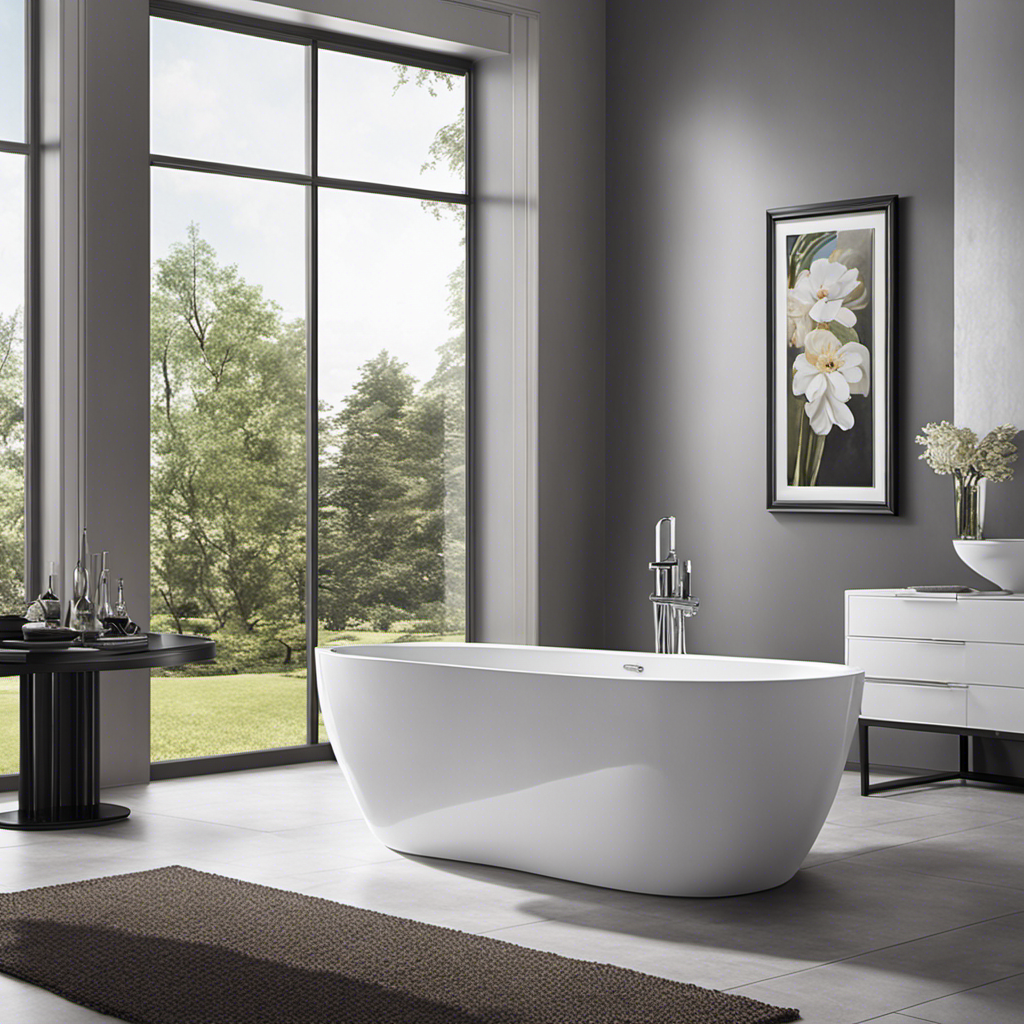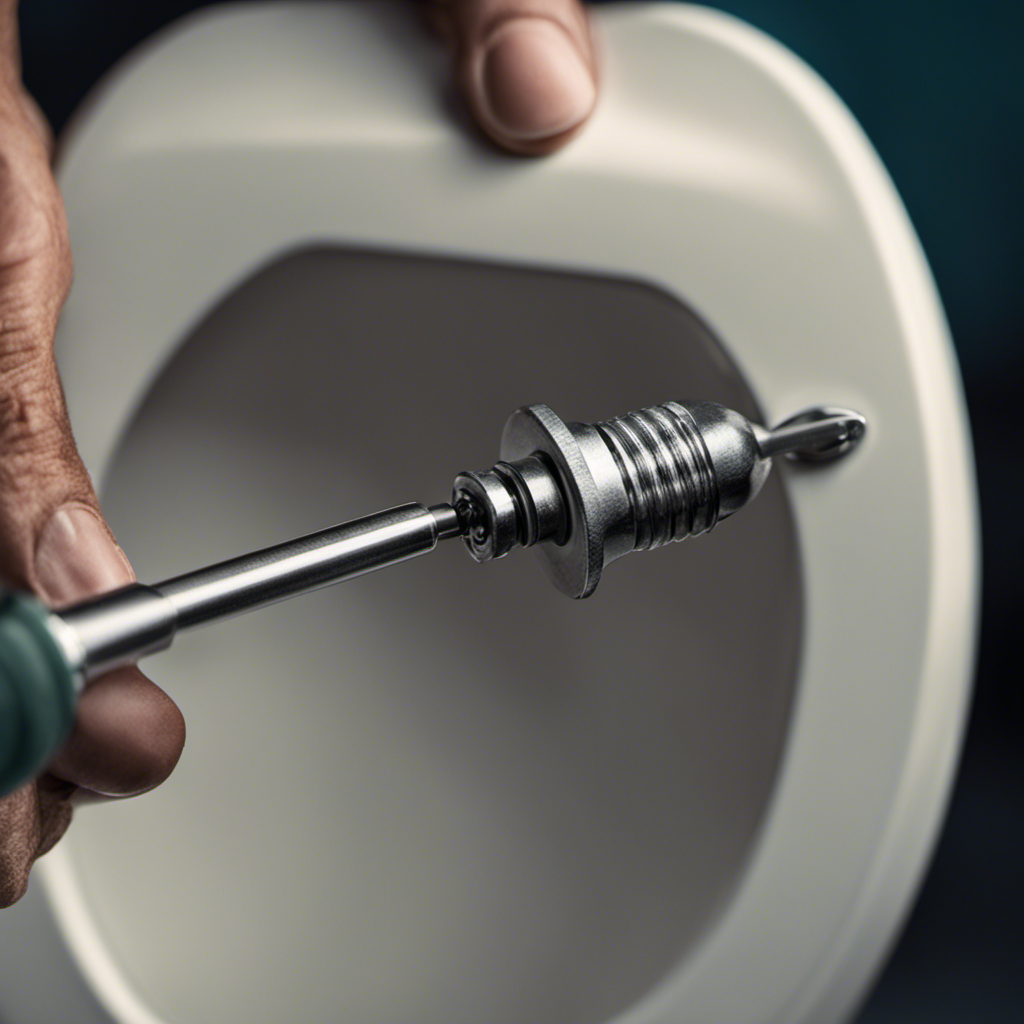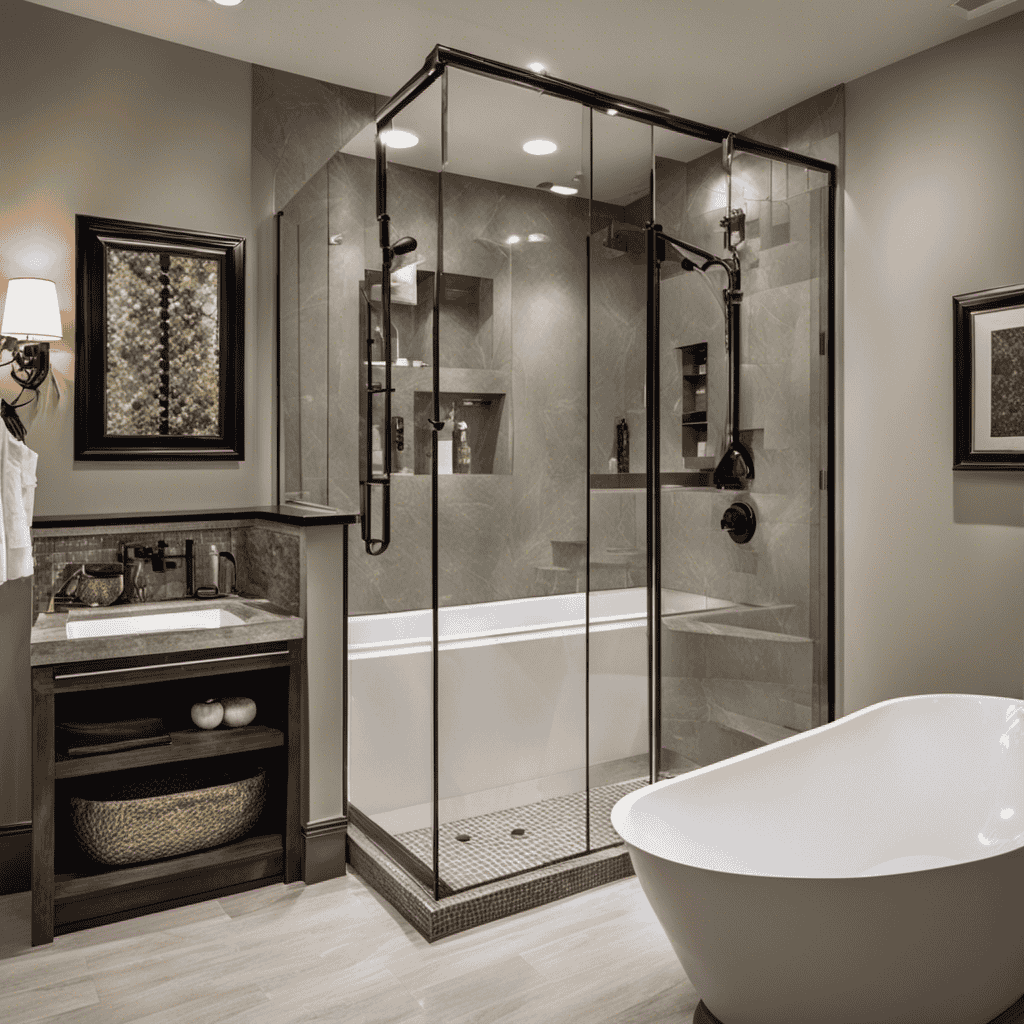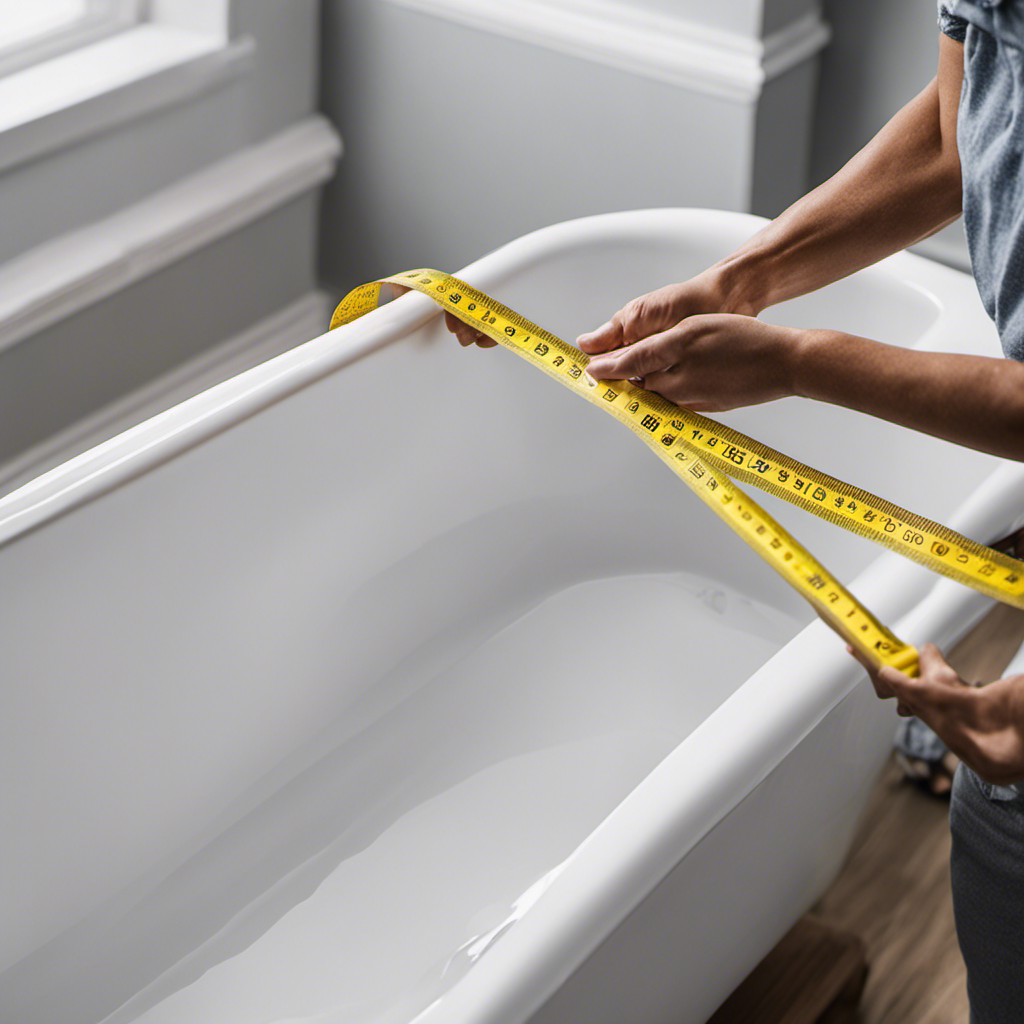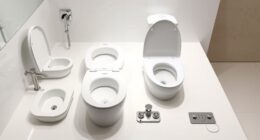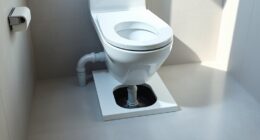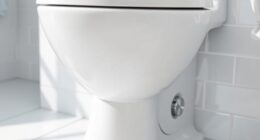Are you tired of cramped and uncomfortable baths? Look no further! In this article, we’ll delve into the world of standard size bathtubs, uncovering their average dimensions, common sizes, and key factors to consider when choosing the perfect fit for your bathroom.
Get ready to luxuriate in a spacious and relaxing tub, where you can unwind after a long day. Let’s dive in and discover the ideal standard size bathtub for you!
Key Takeaways
- The typical dimensions of a standard bathtub are 60 inches long by 30 inches wide.
- Average bathtub dimensions vary, with lengths ranging from 60 to 72 inches, widths ranging from 30 to 32 inches, and depths ranging from 14 to 20 inches.
- The size of the bathtub should be chosen based on the available space in the bathroom.
- Different bathtub materials, such as acrylic, fiberglass, porcelain, cast iron, and stone, offer various advantages and considerations in terms of durability, cleanliness, and aesthetics.
Average Dimensions of Standard Bathtubs
The average dimensions of a standard bathtub are typically 60 inches long by 30 inches wide.
When it comes to bathtub materials, there are various options available in the market. You can choose from materials like acrylic, fiberglass, cast iron, and porcelain. Each material has its own set of benefits and considerations in terms of durability, maintenance, and cost.
The installation process of a bathtub involves several steps. First, the old bathtub needs to be removed, followed by preparing the plumbing and drain connections. Then, the new bathtub is carefully placed and leveled. Finally, the surrounding area is sealed and finished to ensure a watertight installation.
Understanding the dimensions and materials of a standard bathtub is essential before moving on to exploring the common sizes available in the market.
Common Sizes of Bathtubs
One of the most common bathtub sizes is typically around 60 inches in length. Typical bathtub dimensions can vary, but the 60-inch length is a popular choice for many homeowners. This size provides enough space for most people to comfortably stretch out and relax.
When choosing the right bathtub size for your bathroom, it’s important to consider the space available and your personal preferences. If you have a smaller bathroom, you may need to consider a smaller bathtub size to maximize the available space. On the other hand, if you have a larger bathroom and enjoy soaking in a spacious tub, you might consider a larger size, such as a 72-inch or even a 84-inch bathtub.
Ultimately, the right bathtub size depends on your specific needs and the dimensions of your bathroom.
Standard Bathtub Measurements
When choosing the right bathtub for your bathroom, it’s important to consider the measurements that will best fit your space and preferences. Here are some key points to keep in mind when it comes to standard bathtub measurements and how to measure for a bathtub:
-
Average Bathtub Dimensions: The average length of a standard bathtub is around 60 inches, while the width typically ranges from 30 to 32 inches. The depth can vary from 14 to 20 inches, providing ample space for a comfortable soak.
-
Measuring for a Bathtub: Start by measuring the length and width of the space where the bathtub will be installed. Make sure to account for any alcoves or walls that may limit the dimensions. Consider the height of the tub as well, especially if you have specific preferences or physical needs.
-
Door and Accessibility: If you’re considering a bathtub with a door for easier accessibility, measure the doorway to ensure the tub can be installed without any issues.
-
Additional Considerations: Don’t forget to measure the distance from the bathtub to other fixtures, such as the toilet or sink, to ensure there’s enough space for comfortable movement in your bathroom.
Typical Dimensions for Bathtubs
If you’re looking for a bathtub that fits comfortably in your bathroom, it’s important to consider the typical dimensions. The average bathtub dimensions range from 60 inches in length to 32 inches in width.
However, it’s essential to note that there are variations in sizes to accommodate different bathroom layouts and personal preferences.
When choosing the right bathtub size, you should consider the size of your bathroom and the available space. If you have a small bathroom, you may opt for a compact bathtub with dimensions around 54 inches in length and 30 inches in width.
On the other hand, if you have a spacious bathroom, you can go for a larger bathtub with dimensions up to 72 inches in length and 42 inches in width.
Remember to measure your bathroom accurately and consider your comfort when selecting a bathtub size that suits your needs.
Standard Bathtub Sizes and Dimensions
It’s important to note that there are variations in sizes to accommodate different bathroom layouts and personal preferences. When it comes to standard bathtubs, there are a few key points to consider:
-
Average cost of standard bathtubs: Standard bathtubs can range in price depending on the material, brand, and features. On average, you can expect to pay anywhere from $300 to $1,500 for a standard bathtub.
-
Benefits of larger bathtub sizes: Larger bathtub sizes offer several benefits. They provide more space for relaxation and comfort, allowing you to fully stretch out and unwind after a long day. They also offer flexibility for couples or families who want to bathe together or have children bathe in the same tub.
-
Considerations for bathroom space: Before choosing a larger bathtub size, it’s important to consider the available space in your bathroom. Ensure that there is enough room to accommodate the larger dimensions without it feeling cramped.
-
Installation and plumbing requirements: Larger bathtubs may require additional plumbing work and installation considerations. It’s essential to consult with a professional to ensure proper installation and to understand any potential modifications needed for your bathroom.
Understanding Standard Bathtub Dimensions
When it comes to choosing a bathtub, understanding the common sizes is key. Factors such as the dimensions of your bathroom space, your personal preferences, and any specific needs or limitations you may have will all affect the size of bathtub that will work best for you.
Finding the right fit involves considering both the practical and aesthetic aspects, ensuring that your bathtub not only fits comfortably in your bathroom but also meets your desired level of comfort and style.
Common Bathtub Sizes
You’ll find that common bathtub sizes vary depending on the model and manufacturer. Here are four key points to consider when exploring the world of common bathtub sizes:
-
Bathtub design trends: Keep in mind that bathtub design trends are constantly evolving. From sleek and modern freestanding tubs to classic and traditional alcove tubs, there is a wide range of options to choose from.
-
Benefits of different bathtub materials: Different materials offer various benefits. For example, acrylic tubs are lightweight, durable, and retain heat well, while cast iron tubs are known for their timeless appeal and excellent heat retention.
-
Standard sizes for alcove tubs: Alcove tubs, which are designed to fit into a three-wall enclosure, typically come in standard sizes such as 60 inches long, 30 inches wide, and 14 inches deep.
-
Freestanding tub sizes: Freestanding tubs, which can be placed anywhere in the bathroom, come in various sizes ranging from smaller soaking tubs for compact spaces to larger luxurious tubs for a spa-like experience.
Understanding these common bathtub sizes and design trends will help you make an informed decision when choosing the perfect bathtub for your bathroom. Now, let’s explore the factors that affect bathtub dimensions.
Factors Affecting Dimensions
Factors such as bathroom layout and personal preference greatly influence the dimensions of a bathtub. When it comes to choosing the right size for your bathtub, it’s important to consider these factors in order to create a comfortable and functional space.
Additionally, current bathtub design trends and the availability of different materials play a role in determining the dimensions of a bathtub. For example, if you prefer a more minimalist and modern look, you may opt for a smaller, freestanding bathtub made of materials like acrylic or stone. On the other hand, if you have a larger bathroom and enjoy luxuriating in a deep soak, a larger, built-in bathtub made of materials like cast iron or porcelain may be more suitable.
Ultimately, the dimensions of your bathtub should be tailored to your specific needs and preferences.
Finding the Right Fit
To ensure a comfortable and functional bathroom space, it’s important to consider your personal preferences and available materials when selecting the dimensions of your bathtub. Here are four key factors to keep in mind when finding the right fit for your bathroom:
-
Size: Measure the available space in your bathroom to determine the maximum dimensions for your bathtub. Consider the overall layout and how much space you want to allocate for other fixtures.
-
Style: Decide on the style of bathtub that suits your taste and complements the overall design of your bathroom. There are various options available, such as freestanding, alcove, corner, and drop-in tubs.
-
Materials: Choose bathtub materials that are durable, easy to clean, and resistant to stains and scratches. Common options include acrylic, fiberglass, porcelain, and cast iron.
-
Installation process: Consider the installation process and whether you have the necessary skills and tools to install the bathtub yourself. If not, hiring a professional can ensure a proper and secure installation.
Key Factors to Consider for Bathtub Sizing
When choosing the size of your bathtub, it’s important to consider several key factors.
First, think about the materials used to make the bathtub. Different materials, such as acrylic, cast iron, or fiberglass, can affect the overall size and weight of the bathtub. For example, a cast iron bathtub will be heavier and may require additional support during installation.
Additionally, you need to consider the available space in your bathroom. Measure the area where the bathtub will be placed to ensure it fits properly.
Lastly, consider the installation process. Will the bathtub be installed as a freestanding unit or against a wall? This will also impact the size and dimensions you choose.
Frequently Asked Questions
Are Standard Bathtubs Suitable for Small Bathrooms?
Standard bathtubs can be suitable for small bathrooms, but it’s important to consider the dimensions. There are alternatives to standard bathtubs, like corner or freestanding tubs, that can be more space-efficient options.
Can I Install a Standard Bathtub in a Mobile Home?
Yes, you can install a standard bathtub in a mobile home. However, it is important to consider the installation requirements and durability considerations. Make sure the structure can support the weight and that the plumbing is suitable.
What Materials Are Commonly Used to Make Standard Bathtubs?
You’ll love bathing in a standard bathtub made of common materials like acrylic, porcelain, or fiberglass. These materials are durable and provide a luxurious bathing experience. Get ready to soak and relax!
Are There Any Regulations or Building Codes That Dictate the Size of a Standard Bathtub?
Regulations and building codes can influence the size of a standard bathtub. These guidelines ensure safety and accessibility. Factors like the type of building and intended use may determine the specific requirements for bathtub dimensions.
Can I Customize the Dimensions of a Standard Bathtub to Fit My Specific Needs?
You have the power to tailor the measurements of a standard bathtub to meet your unique requirements. By opting for custom bathtub dimensions, you can create a personalized oasis that perfectly suits your needs.
Conclusion
So now you know all about standard size bathtubs! From the average dimensions to common sizes, you have a clear understanding of what to look for when choosing a bathtub.
Remember to consider your space and personal preferences when deciding on the right size for you. With this knowledge, you can confidently embark on your quest for the perfect bathtub that will provide you with relaxation and comfort.
So, why wait? Start exploring the world of standard bathtubs today!
